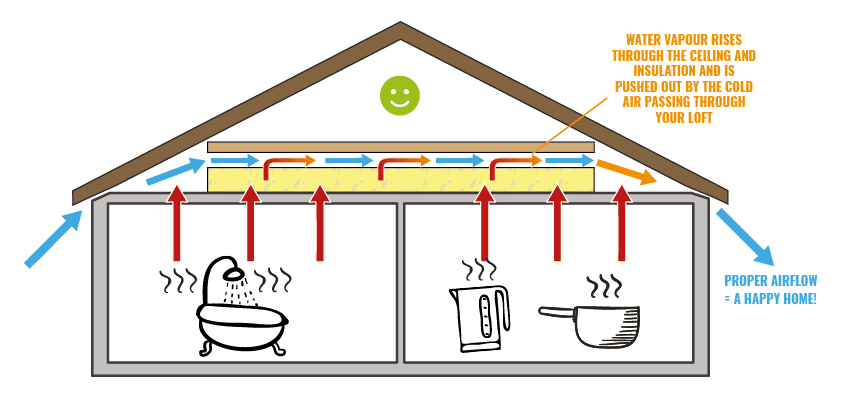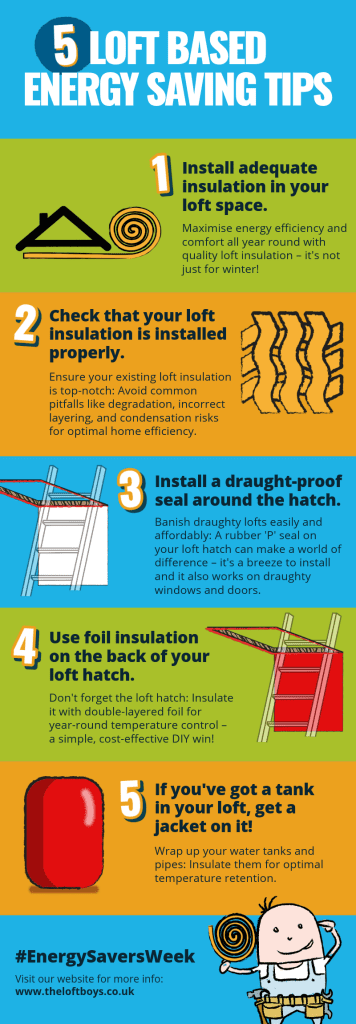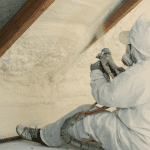It’s 2024 already – how the heck did that happen? – and we’re supporting the Energy Savers Week (15 – 21 January) organised by those lovely people over at Citizens Advice and the Energy Saving Trust. As part of that campaign, they have put together some great tips on how to stay warm this winter and save money on your heating.
To support their campaign we’ve put together our loft-related energy-saving tips which we hope you’ll find useful. Plus we’ve compiled a list of other insulated-related content and guides we’ve created over the years which we think could also come in handy if you’re doing a deep dive into the fascinating and rewarding world of loft insulation!
Without further ado, here are our five loft based energy saving tips to warm your cockles:
1. Install adequate insulation in your loft space.
This sounds like a no-brainer but you’d be surprised how many people we talk to who haven’t got the foggiest idea what’s in their loft, let alone whether there’s insulation in there!
By now, most of you should already have heard about the benefits of decent loft insulation, but if you’re still in the dark (that’s a loft industry pun!), then the main one is that it stops all that heat you worked hard for escaping through your roof. Also, a benefit that people often don’t consider, is that the insulation works in the other direction too, and will help to stop warm air from entering your home from the loft during summer. Therefore good insulation will mean you pay less for energy and since your home will be more energy-efficient you’ll be helping the environment to boot. Not bad aye?
So if you haven’t got any – get some! And if you can’t access your loft to check don’t despair, in this blog post you’ll find tips on how to do it.
2. Check that your loft insulation is installed properly.
If you already have insulation that’s great but don’t get too comfy just yet buddy… there’s a good chance – and we see this all the time I’m afraid – that it’s degraded or laid incorrectly which can cause heat loss or condensation. The insulation needs to cover the whole floor space of your loft and you should have two layers for optimal thermal efficiency.
Many companies (such as us at The Loft Boys) offer free no-obligation surveys to ascertain what state your insulation is in. However, if you’re a more “get on with it kind of person,” then we offer the following advice:
Check that the base layer is installed between the joists, running in line with them. The second layer (if one is present) must be installed at a right angle to the base layer to prevent thermal bridging through the joists.
Check if the insulation has been relaid after being moved to allow access to utilities, or to reveal joists to allow for movement around the loft space.
If you have a storage platform, check that it’s not squashing the insulation and that there’s a small gap between the top of the insulation and under the surface of the platform – if this isn’t the case you could get condensation and it’s related problems such as mould and health risks.
There may also be missing insulation if a water tank has been removed which generally has no insulation beneath them. This will potentially expose sections of the ceiling causing heat loss.
Also, insulation that doesn’t cover enough of the ceiling into the eaves, or is too far into the eaves. There is a fine balance needed here to ensure sufficient airflow and the reduction of heat loss. In this part of your loft, the focus should be on airflow and the prevention of condensation.
3. Install a draught-proof seal around the edge of your loft hatch.
There’s nothing worse than feeling a horrible draught when walking under your loft hatch but there’s a simple and cheap way of solving this. Using a simple rubber ‘P’ seal applied to the loft hatch door stop, that acts as a retainer for your trapdoor when shut can make a huge difference – a roll of this will only set you back about 6 quid on Amazon! In this guide, we show you how it can be done.
And it’s worth noting that if you’ve got draughts in any other parts of your home like under or around doors and windows, this method can help with those too.
4. Use foil insulation on the back of your loft hatch.
Argh, the loft hatch also needs to be insulated, come on, this is ridiculous!!! Yes my friend, sorry to say that you could have done all of the work of neatly and expertly insulating your loft and adding a draught seal to the hatch only for some of that expensive heat to escape through the hatch itself. But, as with the draught-proof seal, the good news is that it’s a very inexpensive trick and easy to install yourself with basic DIY skills. Double-layered insulation foil is the ticket here (with lots of options for under £20) and the beauty of this is that just like loft floor insulation, it also keeps excess heat from entering through the hatch during the summer months. Cool!
5. If you’ve got a tank in your loft, get a jacket on it!
No, we don’t mean a military tank although if your loft is large enough to accommodate one we’d love to just come and gawk at it (the loft, not the tank)! We’re talking more about water tanks or heaters etc. or any water pipes for that matter. They should have an insulated jacket (also referred to as lagging) on them to help retain their temperature. Alas, this is not something we help with directly but these materials are readily available and if you need any advice we’d be happy to help.
Conclusion
In short, sufficient, correctly laid insulation, as well as taking care of the other things we’ve highlighted above, will save you money on your energy bills, and will also keep your place warm in the colder months (and cool in the warmer months). Secondly, you’ll benefit from a condensation-free loft space. Nice!
For anyone interested in reading on, we’ve compiled a list below of some of our most useful loft insulation-related resources.
Finally, if you’re considering getting some insulation installed in your home and would like a rough price, head over to our package builder or get started on a quote.
Stay warm people!
Was this post useful? Here are some other’s you might like...










